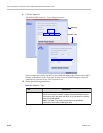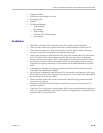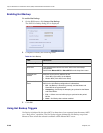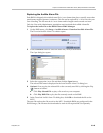
Chapter 21-RealPresence Collaboration Server (RMX) Administration and Utilities
Polycom, Inc. 21-39
• Gateway Profiles
• IVR services (excluding .wav files)
• Recording Link
•Profiles
• IP Network Settings:
— H.323 settings
— SIP settings
— DNS settings
— Fix Ports (TCP, UDP) settings
— QoS settings
Guidelines
•Both Master and Slave MCUs must have the same software version installed.
•The Users list and Passwords must be the same on both the Master and Slave MCUs.
• There must be connectivity between the Master and Slave MCUs, either on the same
network or on different networks connected through routers.
• In the event of failure of the Master MCU the Slave MCU assumes the role of the Master
MCU. The Master/Slave relationship is reversed: the Slave, now active, remains the
Master and the previous Master MCU, when restarted, assumes the role of Slave MCU.
• No changes to the Slave MCU are permitted while it is functioning as the Hot Backup.
Therefore no ongoing conferences or reservations can be added manually to the Slave
MCU.
•If Hot Backup is disabled, all ongoing conferences and Reservations backed up on the
Slave MCU are automatically deleted.
•In Hot Backup configuration, the SIP and H.323 Authentication configuration of the User
Name and Password in the IP Network Service Properties - Security tab of the Master RMX
are not backed up in the Slave RMX.
• Master and Slave initial roles can be reversed only after all ongoing conferences and
Reservations are deleted.
• Changes to the Master MCU that require a System Reset can only be made after Hot
Backup is disabled.
• Video/Voice Port Configurations on the Master MCU are not synchronized with the Slave
MCU. You must manually set the Video/Voice Port Configurations on both the Master
and Slave MCUs to the same level.


















